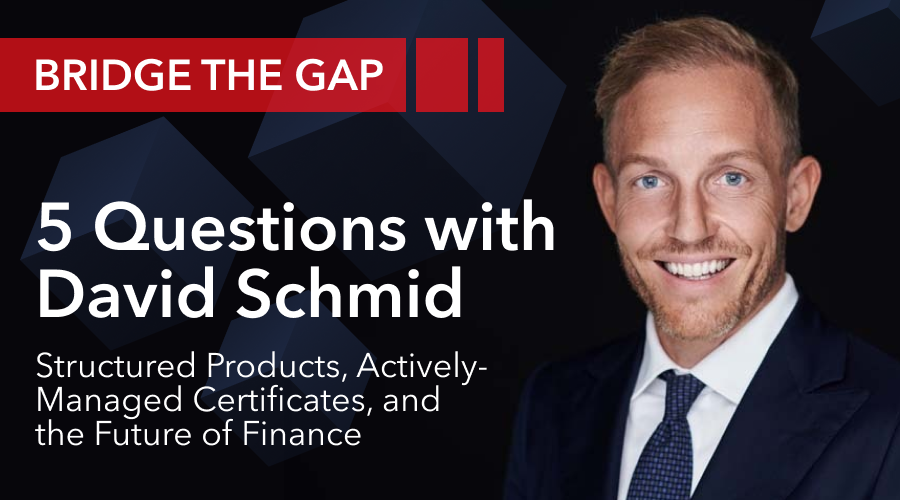Volatility, AI and Flexibility: 5 Burning Questions on Structured Products with David Schmid

We speak with David Schmid, Co-CEO and Partner at Maverix Securities, as he shared some of his thoughts on structured products and Actively Managed Certificates (AMCs), how they’ve grown in popularity recently, and what the future of wealth management looks like as digital assets enter the mainstream.
Read on for an exclusive look into the burgeoning field of structured products and AMCs!
Volatility seems to be the theme of 2025. With structured products often being pitched as tools for managing risk while capturing upside potential, how do you see these products fitting into the modern high-net-worth portfolio, especially in the current economic environment?
In a market where uncertainty remains the only constant, structured products offer a unique blend of protection and opportunity. High-net-worth investors are increasingly seeking strategies that can provide a degree of certainty without completely sacrificing performance. Structured products, when designed thoughtfully, can do exactly that—mitigate downside risk while offering tailored exposure to specific market themes or asset classes.
What’s particularly interesting is how this trend plays out globally. In Europe, we see investors focusing more on capital preservation amid concerns over monetary policy fragmentation and regulatory tightening. In Asia, the flow was heavily skewed towards flow equity-linked products. While equity FCNs, ELNs, Accumulators and Decumulators remain the most popular, we’re seeing a clear uptick in demand for products linked to Credit, Rates, FX, and even digital assets. Driven by innovation-friendly regulation and an increasingly sophisticated client base, Asian investors are often ahead of the curve when it comes to embracing structured solutions as core portfolio tools. Across all regions, structured products are no longer niche—they’re becoming foundational.
Many investors appreciate the flexibility of AMCs for implementing tailored strategies. What do you see as the primary benefits of AMCs over more traditional investment vehicles, and where do you think they add the most value?
AMCs offer a level of flexibility that traditional vehicles like funds often can’t match—especially in terms of speed to market and the ability to execute niche or tactical strategies. For wealth managers and family offices, AMCs allow for direct implementation of bespoke ideas without the heavy operational and regulatory burden of a fund setup. Their transparency and cost-efficiency make them particularly attractive in an environment where agility is key. At Maverix, we see AMCs as strategic enablers for clients looking to differentiate themselves with innovative and relevant investment offerings.
In recent years, digital assets have emerged as a compelling, if volatile, asset class. How do you see structured products bridging the gap between traditional finance and digital assets?
Digital assets are no longer a fringe topic—they’re now part of strategic conversations across the wealth management spectrum. Yet, the complexity and volatility of the space remain real barriers. Structured products can play a crucial role here by providing defined risk-reward profiles, capital protection features, or yield strategies tied to digital assets. This bridges the knowledge and risk gap, enabling more traditional investors to access the space with a level of comfort and control.
In particular AMCs can act as a bridge between traditional finance and digital assets. Despite using a conventional ISIN structure — fully bankable and compatible with private banking systems — their AMCs offer streamlined access to digital assets within a regulated and familiar setup. This enables investors and advisors to engage with this emerging asset class efficiently and without operational hurdles. Our role is to bring institutional-grade structure and risk management to an otherwise fast-moving and often opaque asset class.
What role do you see technology playing in the future of structured products? Are innovations like AI-driven strategies likely to transform this space in the coming years?
Technology is already reshaping how we originate, structure, and manage these products. The next frontier is in data-driven design and AI-powered portfolio construction. At Maverix, we’re actively exploring ways to integrate machine learning into idea generation and product optimization. But beyond that, it’s about the entire client journey—automation, faster execution, seamless reporting. As platforms become more intelligent and interconnected, we’ll see a shift toward hyper-personalized investment solutions delivered at scale. For structured products, that’s a game-changer.
Finally, are there specific developments or innovations from Maverix that we should look out for that would make these solutions even more valuable for high-net-worth investors?
Absolutely. We’re building next-generation infrastructure that combines traditional structured product expertise with modern technology and digital asset integration. One example is our “Staking+” ETPs—products that deliver staking yields in a secure and regulated format. Another good example is our DeFi Strategy where we are farming yields on stablecoins within an AMC. Finally, we’re also investing heavily in our platform capabilities to enable faster issuance, better customization, and end-to-end transparency. Our goal is to empower clients to move from idea to execution in days, not weeks. For us, innovation isn’t just about products—it’s about rethinking the entire experience.
Want to keep ahead with timely insights and in-depth market analyses? Click HERE to sign up for our newsletter today!
